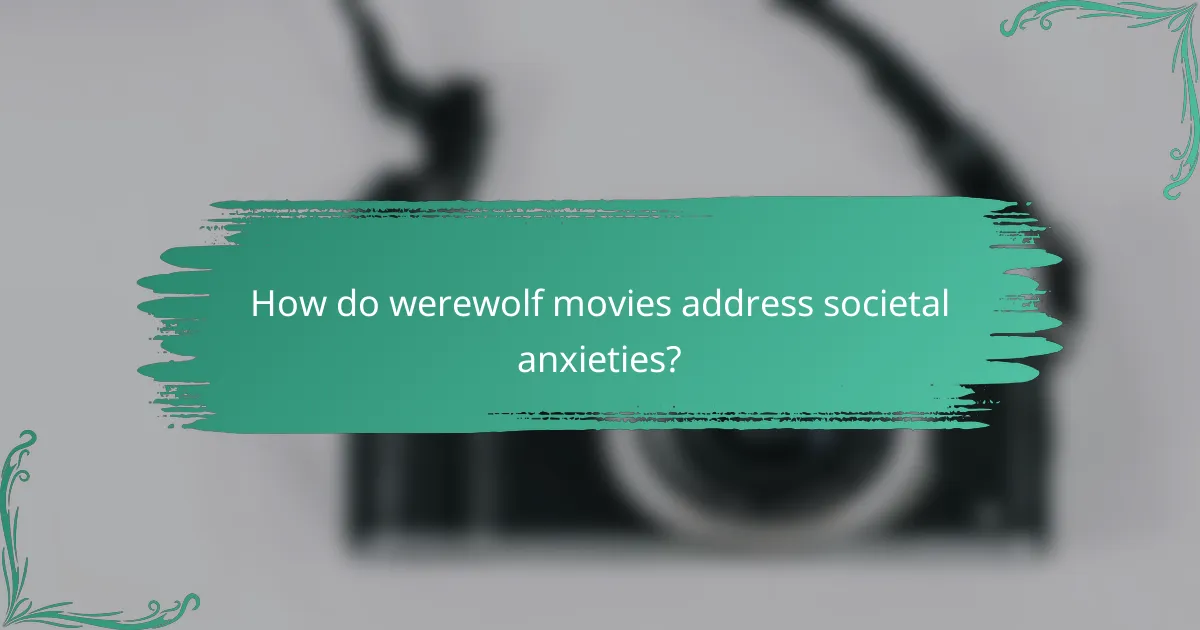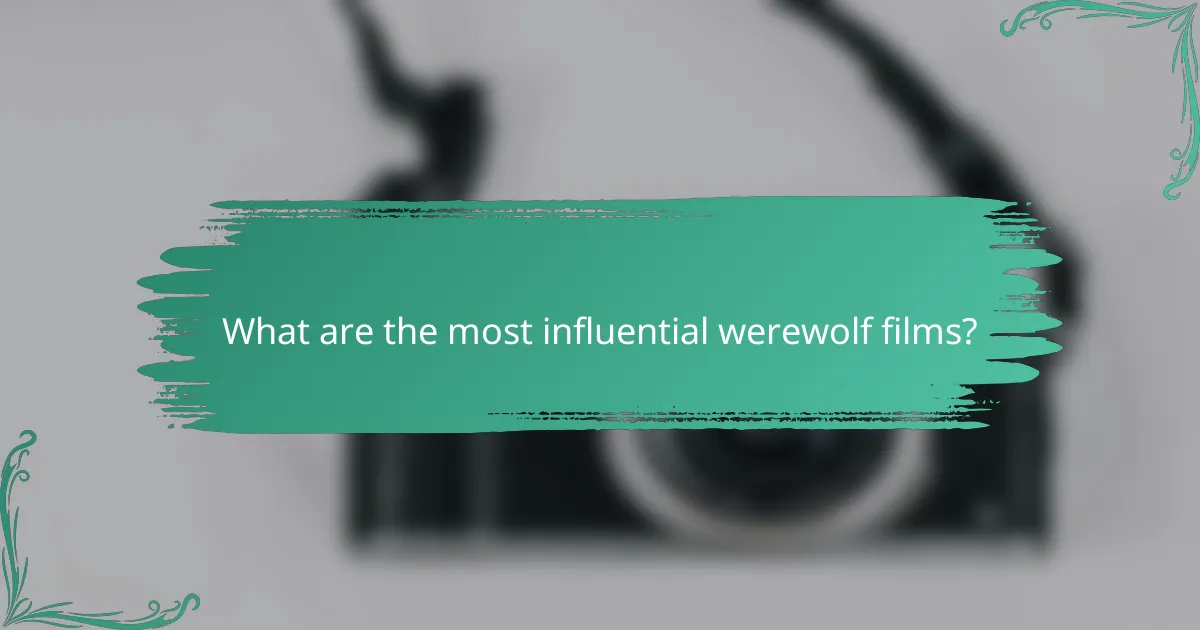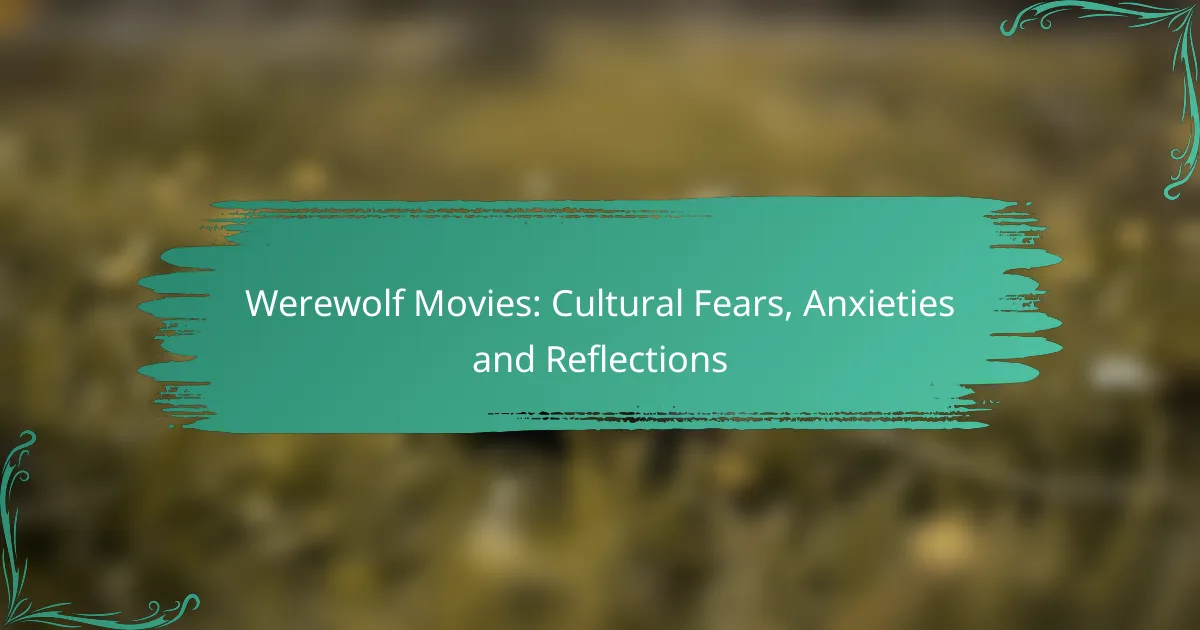Werewolf movies serve as a lens through which cultural fears and anxieties are examined, particularly those surrounding transformation, loss of control, and the primal instincts inherent in humanity. By portraying the tension between civilization and the wild, these films resonate with audiences, reflecting deeper concerns about identity and morality. Iconic titles like “The Wolf Man” and “American Werewolf in London” have not only shaped the horror genre but also influenced societal perceptions of the werewolf mythos.

What are the cultural fears reflected in werewolf movies?
Werewolf movies encapsulate various cultural fears, including the unknown, transformation, loss of control, societal rejection, and violence. These themes resonate deeply with audiences, reflecting anxieties about identity, morality, and the primal instincts lurking within humanity.
Fear of the unknown
The fear of the unknown is a central theme in werewolf movies, often represented by the mysterious transformation from human to beast. This transformation symbolizes the unpredictability of life and the terror of what lies beyond human understanding. Audiences are drawn to the suspense of not knowing when or how the change will occur.
In many films, the werewolf’s origins are shrouded in mystery, heightening the fear associated with the unknown. This can reflect societal anxieties about unfamiliar cultures, technologies, or even personal relationships that disrupt the status quo.
Fear of transformation
Transformation in werewolf narratives often signifies a loss of identity and the struggle between civilization and primal instincts. Characters grapple with their duality, highlighting the fear of losing one’s humanity. This reflects broader societal concerns about personal change and the anxiety that accompanies significant life transitions.
For instance, a character may initially embrace their newfound power but later fear the consequences of their transformation. This duality resonates with audiences who may face their own transformations, whether through aging, social changes, or personal crises.
Fear of losing control
The fear of losing control is prevalent in werewolf films, where characters often find themselves unable to manage their actions during transformations. This loss of control can lead to destructive behavior, symbolizing the fear of succumbing to one’s darker impulses. It resonates with the anxiety of being overwhelmed by emotions or circumstances.
Many narratives illustrate this struggle, where the protagonist must confront their inner beast, often leading to tragic consequences. This theme serves as a cautionary tale about the importance of self-regulation and the potential chaos that can arise from unchecked desires.
Fear of societal rejection
Societal rejection is a recurring fear in werewolf stories, as characters often face ostracism or persecution due to their transformations. This reflects a broader cultural anxiety about being different or not conforming to societal norms. The werewolf becomes a metaphor for those who feel marginalized or misunderstood.
In many films, the protagonist’s struggle for acceptance highlights the human desire for belonging and the fear of being cast out. This theme resonates particularly in contemporary society, where issues of identity and acceptance are increasingly relevant.
Fear of violence
Violence is a significant element in werewolf narratives, often depicted through the brutal nature of the transformations and the havoc they wreak. This fear reflects societal anxieties about aggression and the darker aspects of human nature. Werewolves embody the potential for violence that exists within everyone, tapping into primal fears about safety and security.
Additionally, the portrayal of violence in these films can serve as a commentary on real-world issues, such as crime and societal breakdown. The visceral nature of the werewolf’s attacks often leaves audiences questioning the boundaries of morality and the consequences of unchecked aggression.

How do werewolf movies address societal anxieties?
Werewolf movies often reflect societal anxieties by portraying the struggle between civilization and primal instincts. These films tap into fears about loss of control, the unknown, and the darker aspects of human nature, making them a powerful medium for exploring contemporary issues.
Reflection of human nature
Werewolf films frequently highlight the duality of human nature, showcasing the conflict between civilized behavior and primal urges. Characters often grapple with their inner beast, symbolizing the struggle against inherent aggression and savagery. This reflection prompts viewers to confront their own darker impulses and societal norms.
For example, in classics like “An American Werewolf in London,” the transformation into a werewolf serves as a metaphor for the chaotic aspects of human identity. The struggle to maintain humanity while facing overwhelming instincts resonates with audiences, illustrating the thin line between civility and chaos.
Commentary on identity
These films often explore themes of identity, particularly how external circumstances can alter one’s sense of self. The werewolf transformation can symbolize a loss of control over personal identity, reflecting societal fears about conformity and the pressures to fit in. Characters may face alienation as they navigate their dual identities, which can resonate with viewers experiencing similar conflicts.
In “The Wolfman,” the protagonist’s struggle with his identity highlights the tension between societal expectations and personal truth. This commentary encourages audiences to consider how identity can be shaped by both internal and external forces, prompting introspection about their own lives.
Exploration of morality
Werewolf movies delve into moral dilemmas, questioning the nature of good and evil. The transformation into a werewolf often raises ethical questions about responsibility and the consequences of one’s actions. Characters must confront the ramifications of their primal behavior, challenging viewers to consider the moral implications of their own choices.
In films like “Ginger Snaps,” the werewolf metaphorically represents the tumult of adolescence, exploring themes of morality in the context of growing up. This exploration encourages audiences to reflect on their moral compass and the societal standards that influence their decisions, making the genre a compelling vehicle for ethical discussions.

What are the most influential werewolf films?
The most influential werewolf films have shaped the genre by exploring themes of transformation, identity, and societal fears. Key titles like “The Wolf Man,” “American Werewolf in London,” and “Ginger Snaps” have left a lasting impact on horror cinema and cultural perceptions of the werewolf mythos.
The Wolf Man (1941)
“The Wolf Man” is a seminal film that established many conventions of the werewolf genre. It tells the story of Larry Talbot, who transforms into a wolf-like creature after being bitten by one. The film’s exploration of duality and the struggle between man and beast resonates with audiences, reflecting deep-seated fears of losing control.
This film introduced iconic elements such as the full moon triggering the transformation and the use of silver as a means to defeat the creature. Its influence can be seen in countless adaptations and references in popular culture, solidifying its status as a classic.
American Werewolf in London (1981)
“American Werewolf in London” blends horror and dark comedy, offering a unique take on the werewolf legend. The story follows two American backpackers who encounter a werewolf in the English countryside, leading to one of them becoming a werewolf himself. The film is notable for its groundbreaking special effects, particularly the transformation scene, which remains a benchmark in the genre.
This film also delves into themes of guilt and the consequences of one’s actions, as the protagonist grapples with his new identity. The juxtaposition of humor and horror creates a compelling narrative that has influenced many subsequent films.
Ginger Snaps (2000)
“Ginger Snaps” offers a feminist perspective on the werewolf myth, focusing on the transformation of a teenage girl, Ginger, as she undergoes both physical and emotional changes. The film effectively uses the werewolf metaphor to explore themes of puberty, sexuality, and the bond between sisters. It stands out for its character-driven narrative and social commentary.
The film’s portrayal of the werewolf as a symbol of empowerment and rebellion against societal norms resonates with audiences, making it a cult classic. Its unique approach has inspired a new wave of werewolf films that challenge traditional narratives and explore deeper psychological themes.

How have werewolf films evolved over time?
Werewolf films have transformed significantly from their early horror roots to contemporary interpretations that reflect modern societal fears and anxieties. This evolution showcases changing cultural narratives and advancements in filmmaking techniques.
Classic horror to modern interpretations
Classic werewolf films, such as “The Wolf Man” from the 1940s, primarily focused on the horror of transformation and loss of control. These films often depicted werewolves as tragic figures, embodying the fear of the unknown and the darker aspects of human nature.
In contrast, modern interpretations, like “Teen Wolf” and “The Howling,” often blend horror with humor or drama, showcasing werewolves in more relatable contexts. This shift reflects a broader acceptance of supernatural themes in popular culture, allowing for varied storytelling approaches.
Incorporation of social themes
Recent werewolf films frequently incorporate social themes, addressing issues such as identity, sexuality, and mental health. For instance, “Ginger Snaps” explores female adolescence and the challenges of growing up, using lycanthropy as a metaphor for transformation and empowerment.
This thematic depth allows filmmakers to connect with audiences on a personal level, making the werewolf narrative a vehicle for discussing broader societal anxieties. The werewolf’s duality often symbolizes internal conflicts faced by individuals in contemporary society.
Technological advancements in filmmaking
Technological advancements have significantly enhanced the portrayal of werewolves in film. The use of CGI and advanced makeup techniques has allowed for more realistic transformations and effects, creating a more immersive experience for viewers.
Films like “Underworld” and “The Wolfman” showcase these innovations, blending practical effects with digital enhancements. This evolution not only improves visual storytelling but also expands the creative possibilities for filmmakers, allowing for unique interpretations of the werewolf mythos.

What themes are common in contemporary werewolf cinema?
Contemporary werewolf cinema often explores themes of transformation, identity, and societal fears. These films reflect anxieties about gender, environmental degradation, and the tension between isolation and community.
Gender and sexuality
Gender and sexuality are prominent themes in werewolf films, often symbolizing the struggle between societal norms and personal identity. Many narratives depict the werewolf as a metaphor for repressed desires and the chaos that ensues when these desires are unleashed.
For instance, characters may transform into werewolves during pivotal moments of sexual awakening, highlighting the connection between primal instincts and human sexuality. This theme resonates particularly in films that challenge traditional gender roles and explore fluidity in identity.
Environmental concerns
Environmental issues frequently surface in werewolf cinema, reflecting fears about humanity’s impact on nature. The werewolf often embodies the consequences of ecological neglect, serving as a reminder of the wildness that exists within both nature and humanity.
Films may illustrate the devastation of natural habitats and the resulting transformation of individuals into werewolves as a response to environmental crises. This connection emphasizes the need for a harmonious relationship with the earth, warning against the dangers of exploitation and neglect.
Isolation and community
Isolation and community dynamics are central to many werewolf stories, often portraying the tension between individual desires and societal expectations. Characters may grapple with feelings of alienation, particularly as they undergo their transformations, which can lead to a loss of connection with their communities.
Conversely, some narratives explore the formation of new communities among werewolves, emphasizing themes of acceptance and belonging. This duality illustrates the struggle for identity in a world that often fears the unknown, highlighting the importance of understanding and empathy in overcoming isolation.
